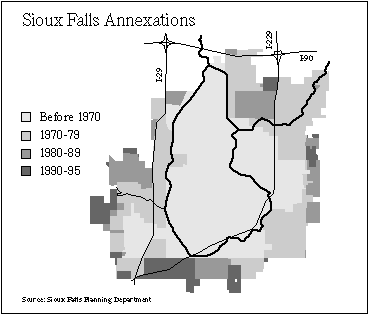Unlike some regional growth centers in the Upper Midwest, Sioux Falls' expansion has not focused in one general direction or area of the city. Rather, the city has grown concentrically, like a tree, according to Don Seten, urban planner for Sioux Falls' Department of Planning and Building Services.
Sioux Falls does not have "leapfrog" communities developing outside the city limits that are stressing city infrastructure, or development that is necessarily restricted by boundaries. All in all, the city's growth is well-managed, Seten says, and urban sprawl is definitely not a term that applies to Sioux Falls.
However, Seten says that some might interpret the growth of South Dakota's largest city as sprawling. In 1970, with a population of 72,000, the city covered 27 square miles; today, the city has nearly doubled to 50 square miles to support 115,000. Also, in the older, central portions of the city with traditional grid streets, there are five to six housing units per acre; in the newly developed fringe areas there are two-and-a-half units per acre on nonthrough, curvilinear streets.
In other words, as Sioux Falls grows it is using more land to accommodate fewer people. "In that sense," Seten acknowledges, "we are sprawling."

Source: Sioux Falls Planning Department
However, that doesn't mean Sioux Falls is experiencing the type of sprawl that is associated with larger cities. Most growing cities experience residential development that "thins out" at the peripheries, Seten says, but what is special about Sioux Falls is that it has a growth management plan that has been in effect since the 1970s. And that plan has been working, according to Mike Cooper, assistant director of the city's Planning and Building Services.
"We don't have urban sprawl like other communities," Cooper says. "The plan of the 1970s was implemented to a 'T.' Today's city limits almost perfectly match the '70s projections," Cooper says. The growth management plan essentially established where developers could expect to receive city infrastructure: If a developer had ideas about an area where the city wasn't ready to commit, the city would say "no," according to Cooper.
There are areas on the fringes of Sioux Falls that are "ready and ripe" for development, Seten says, but the city will insist on concentric development. And it will do that by managing placement of sewer and water lines. "It's just like the old saying," Seten says, "Growth follows the pipe."
But a good growth management plan isn't worth much without the support of the community, Cooper says, and in that respect Sioux Falls has been lucky. "We have a pretty good relationship with the developers," Cooper says, adding that local developers have accepted the plan since its inception.
And the city has also received support from Minnehaha County, which passed stricter development policies about 10 years ago, and Lincoln County, which did the same last year. In Lincoln County, which encompasses Sioux Falls' southern expansion, the county and city have a co-review process for new development, according to Seten. There are still undeveloped lots in rural, unincorporated areas outside Sioux Falls that were cleared in the 1970s, Cooper says, and the counties-which must supply road management and law enforcement-are trying to take control of such development.
Sioux Falls is expected to continue its strong population growth of over 2 percent, leading to about 156,000 in 2015, Seten says, but the city doesn't expect the growth to bring any infrastructure problems, especially regarding sewer and water. The city has a sewage treatment capacity of 169,000.
At the worst, lack of plentiful water may begin to limit growth in 20 years, Seten says. However, South Dakota and neighboring states are currently negotiating about the possible construction of a pipeline from the Missouri; in addition, a reservoir north of the city is expected to meet water demands in the coming years.
"There are pressures on the horizon, but nothing in the next five years," Seten says.





